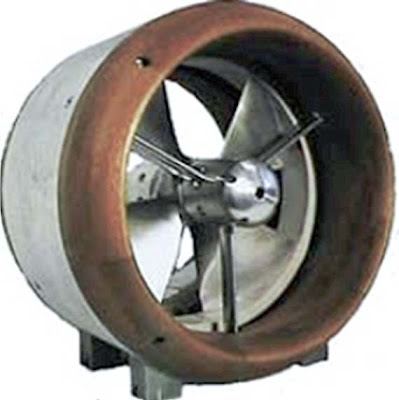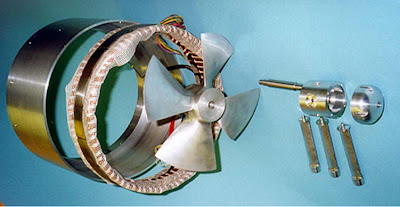Compact Tidal Generator
Why Do some Good Ideas Make it, while others Get Lost in the Works?
(Adapted from a Press release 13th June 2006)
Two researchers a Dr Steve Turnock and a Dr Suleiman Abu-Sharkh at Southhampton University came up with a neat design for an underwater generator which uses very few moving bits. The project got its funding from the Engineering and Physical Sciences Research Council which also published the news of the developments.
What makes this design interesting is its simplicity. “This is a compact design that does away with many of the moving parts found in current marine turbines. It’s a new take on tidal energy generation,” says Turnock. Most generators are essentially wind turbines turned upside down and made to work underwater. They include hefty gearboxes and have to rotate the blades to face into the flow of the water. They turn a half a circle between tides. Gears and moving parts require expensive maintenance and eat up energy from the system, especially when they are used underwater. All this adds to the cost and lessens the power generated.
The Southampton design does not need to turn around because the design of its turbine blades means that they turn equally well, regardless of which way the water flows past them. The blades are also placed in a specially shaped housing that helps channel the water smoothly through the turbine.
Another beauty of the Southampton design is that everything is wrapped in a single package that can be prefabricated so there will be few on-site construction costs. “Just drop it into flowing water and it will start generating electricity. It will work best in fast flowing, shallow water,” says Turnock, who foresees rows of these devices secured to sea floors and riverbeds.
The present prototype is just a tiddler at 25 centimetres across. The researchers are planning larger scale models with improved propeller blades that will further increase the efficiency of generating electricity. All being well, the team envisage the generator becoming commercially available within five years.
The originators "Notes to editors":
Using funding from EPSRC and industry in the early 2000s, Abu-Sharkh, Turnock and their team created a novel tethered underwater vehicle thruster that used electricity to turn a ducted propeller, providing thrust to control the vehicle’s position and speed. Tethered underwater vehicles are extensively used in the offshore industry for conducting underwater inspections and robotic manipulation. An overall propulsion system based on electrical thrusters is much smaller and lighter than the traditional hydraulic thrusters used in tethered underwater vehicles. So using the new ones reduces the weight of the vehicles, meaning that they require less power to move them and so are cheaper to run.
The concept of an electricity generator sprang out of the fundamental research involved in the hydrodynamic and electrical design of the integrated electric thruster. These thrusters, manufactured under licence by the local Hampshire company TSL, are already in use around the world for a variety of underwater vehicle applications.
Funding for these tests (which build on the original EPSRC-funded work) was provided as part of the University of Southampton’s School of Engineering Sciences’ MSc programme in Maritime Engineering Science.
The Engineering and Physical Sciences Research Council (EPSRC) is the UK’s main agency for funding research in engineering and the physical sciences. The EPSRC invests more than £500 million a year in research and postgraduate training, to help the nation handle the next generation of technological change. The areas covered range from information technology to structural engineering, and mathematics to materials science. This research forms the basis for future economic development in the UK and improvements for everyone’s health, lifestyle and culture. EPSRC also actively promotes public awareness of science and engineering. EPSRC works alongside other Research Councils with responsibility for other areas of research.
Speaking to Dr. Stephen Turnock
This morning I had a very interesting talk with Dr Stephen Turnock. A nice guy who took time out to speak about his work.
He told me that the tests to date on the generator have shown satisfactory results and that contracts for the commercial development of the project are in the pipeline. The initial focus of this design will most probably be towards smaller installations, rather that huge 50 meter type of generators. So line up all you guys with small tidal inlets and mountain streams, this yoke might be a better bet than a wind turbine!!
Best wished to Stephen Turnock and his team. Looks like this one will get through the maze!
.





No comments:
Post a Comment